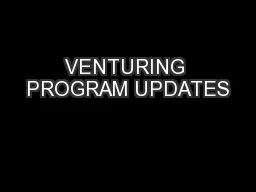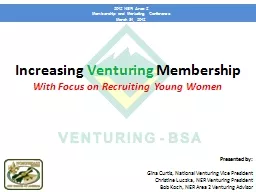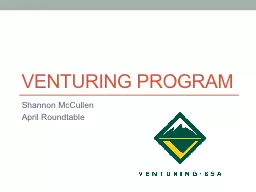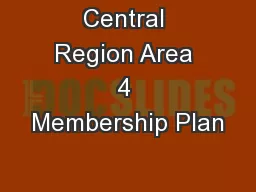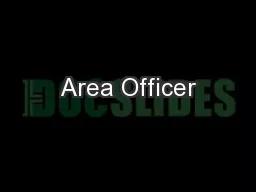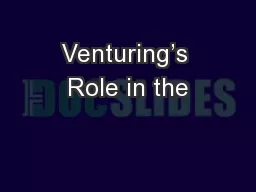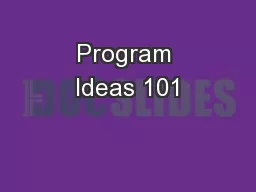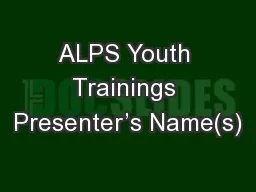PPT-VENTURING PROGRAM UPDATES
Author : tatiana-dople | Published Date : 2017-01-26
INTRODUCTIONS Steven Myers Central Region Area 4 Associate Advisor CommunicationsTraining This presentation created for the Central Region Venturing Planning Meeting
Presentation Embed Code
Download Presentation
Download Presentation The PPT/PDF document "VENTURING PROGRAM UPDATES" is the property of its rightful owner. Permission is granted to download and print the materials on this website for personal, non-commercial use only, and to display it on your personal computer provided you do not modify the materials and that you retain all copyright notices contained in the materials. By downloading content from our website, you accept the terms of this agreement.
VENTURING PROGRAM UPDATES: Transcript
INTRODUCTIONS Steven Myers Central Region Area 4 Associate Advisor CommunicationsTraining This presentation created for the Central Region Venturing Planning Meeting Naperville IL June 2014. Write a sentence or draw image.. Vacant. The cottage was . vacant. and the windows boarded up for the winter. .. The hallways were quiet and . vacant. , and she followed Jonny into the dark . night.. Venturing. Membership. With Focus on Recruiting Young Women. 2012 NER Area 2. Membership and Marketing Conference. March. 31, 2012. Presented by:. Gina Curtis, National Venturing Vice President. Christine Luczka, NER Venturing President. Shannon McCullen. April Roundtable . What is Venturing?. Venturing is a branch of Boy Scouting focusing in high adventure. Venturing seeks to provide positive experiences and help young adults become responsible and mature. Approved March 2014. Updated . May . 2015. 2. What youth want…. From the 2009 national survey. CR Area 4 Mission Statement. The . mission of the national Venturing cabinet and the region and area Venturing officer’s associations is to promote and support the Venturing program, . Presenter’s Name(s). Sea Scouts & Venturing - what happened?. Until 2016, Venturing and Sea Scouts were combined as a single program. In 2016, Sea Scouts became an independent program, similar to Boy Scouts, Cub Scouts, and Venturing. Selection Procedures. Presenter’s Name(s). National. Application Due: Last day of February . Announced By: March 31st. Regional. Application Due: March 15th. Announced By: April 15th. Area. Application Due: March 31st. Scouting Family. Presenter’s Name(s). Age Levels of Programs. Cub Scouts. 1st grade - 5th grade. 7-10 years old. Boy Scouts. 5th grade - 12th grade. 11-18 years old. Venturing and Sea Scouting. 8th grade - Junior year of college (roughly). Presenter’s Name(s). Why the “WOW”?. The number one thing that keeps youth and young adults involved in Scouting is the program offered. Changing/Evolving program increases retention for units. Robert Marlatt. VP Program – PHC. 25 Years Scoutmaster – 7 Units. 5 Years Venture Crew Advisor – 3 Units. Wood Badge Course Director – 15 Courses. BSA . Trainer – 30 years. National Jamboree Scoutmaster. ALPS Model. Adventure, Leadership, Personal Growth, Service. Venturing program model. Framework for a successful program of youth-led adventure. Core Venturing awards provide benchmarks of progress. Venturing, Discovery, Pathfinder, and Summit Awards. Recap of Venturing. Ages 14-21 . (13 graduated 8. th. grade). COED. Awards not Ranks. Gender Neutral. Why recruit girls?. Scouting is a family program. The mission of the Boy Scouts of America is to prepare young people to make ethical and moral choices over their lifetimes by instilling in them the values of the Scout Oath and Law.. Presenter’s Name(s). “If you aren’t recruiting, your crew is dying.”. Picture this:. Boys in a troop are looking for more excitement. Bring in some girls and other friends. Youth graduate from high school. Administration 101 Presenter’s Name(s) Maintain/update operating procedures Supervise trainings (internal and external) Oversees council-wide awards Oversees officer selection Works on recruiting/membership Getting the Word Out Presenter’s Name(s) Methods: Calendars Websites Newsletters Email Facebook Twitter YouTube Create a Communication Strategy: For recruiting For retention For current members For your officers
Download Document
Here is the link to download the presentation.
"VENTURING PROGRAM UPDATES"The content belongs to its owner. You may download and print it for personal use, without modification, and keep all copyright notices. By downloading, you agree to these terms.
Related Documents

